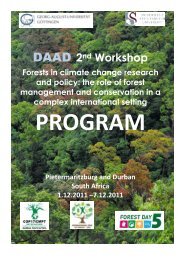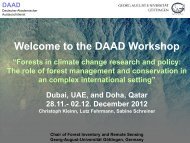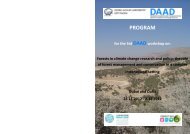Proceedings of the Workshop - Georg-August-Universität Göttingen
Proceedings of the Workshop - Georg-August-Universität Göttingen
Proceedings of the Workshop - Georg-August-Universität Göttingen
Create successful ePaper yourself
Turn your PDF publications into a flip-book with our unique Google optimized e-Paper software.
According to Ortiz (1997), secondary forests can present better efficiency in<br />
carbon fixation than <strong>the</strong> primary forest due to <strong>the</strong> fast grow; <strong>the</strong> carbon is rapidly fixed<br />
in <strong>the</strong> wood because <strong>the</strong>se species produce more biomass. The plantations continue<br />
being a faster alternative for carbon fixation in comparison to native forest.<br />
Never<strong>the</strong>less, in sites with various rotations <strong>of</strong> plants, an inverse effect might<br />
occur. There is an extraction <strong>of</strong> <strong>the</strong> soil nutrients and in <strong>the</strong> long term <strong>the</strong> plantations<br />
growth can decrease. It can also happen in degraded forests if <strong>the</strong>re was no control <strong>of</strong><br />
<strong>the</strong> harvesting individuals; <strong>the</strong> rich genetics are being eliminated and <strong>the</strong> development<br />
and recovery <strong>of</strong> this decreases according to <strong>the</strong> intervention degree in <strong>the</strong> forest<br />
(Schlatter 2010).<br />
4. Conclusions<br />
Forest land-use showed an increase <strong>of</strong> 179440.01 ha, which is attributed by 62.9% to<br />
exotic forest plantations, unlike <strong>the</strong> native forest sub-use decreased 4.1% in its area.<br />
Exotic plantation area increased from sites with previous uses in agriculture (50%),<br />
pasture (35%) and native forest (13%).<br />
125.3ha have been degraded from second-growth forest to open second-growth<br />
forest; extraction <strong>of</strong> wood is one <strong>of</strong> <strong>the</strong> possible causes <strong>of</strong> forest degradation. The<br />
pressure is mainly produced for second-growth forests which in turn helped <strong>the</strong><br />
establishment <strong>of</strong> forestry plantations. However, it was not possible to detect degraded<br />
forests due to <strong>the</strong> scale <strong>of</strong> work.<br />
The native second-growth forest has stock values <strong>of</strong> 10088.6 Mt C and 2626.33 Mt<br />
C for <strong>the</strong> dense and open structures, respectively, while <strong>the</strong> mature native forest<br />
dominates <strong>the</strong> stock to <strong>the</strong> category <strong>of</strong> very dense 25867.28 Mt C in 2007.<br />
The carbon stock decreased for <strong>the</strong> native forest category but increased for <strong>the</strong><br />
forest plantations. In total, a positive balance <strong>of</strong> 20861.1 Mt C was presented due to <strong>the</strong><br />
increase in reforestation plantations.<br />
5. Recommendations<br />
The need is shown to increase <strong>the</strong> spatial resolution <strong>of</strong> <strong>the</strong> territorial information for<br />
detecting internal changes in <strong>the</strong> forest (degradation) for <strong>the</strong> same structure.<br />
6. Acknowledgements<br />
To all <strong>of</strong> <strong>the</strong> laboratory team Geomatics, University Austral <strong>of</strong> Chile, for <strong>the</strong>ir effort and<br />
dedication, who participated in <strong>the</strong> draft update <strong>of</strong> <strong>the</strong> ninth region, without which it<br />
would have been possible to make this work.<br />
The teachers who contributed <strong>the</strong>ir time to resolve our doubts Jorge Gayoso and<br />
Juan Schlatter, and <strong>the</strong> guidance <strong>of</strong> Victor Sandoval, for <strong>the</strong>ir dedication and<br />
unwavering support.<br />
7. References<br />
Aguayo M, A Pauchard, G Azócar & O Parra. 2009. Cambio del uso del suelo en el centro sur<br />
de Chile a fines del siglo XX. Entendiendo la dinámica espacial y temporal del paisaje.<br />
Rev. chil. hist. nat. 3 (82): 361-374.<br />
Armesto J, D Manuschevich, A Mora, C Smith-Ramirez, R Rozzi, A Abrazúa & P Marquet.<br />
2010. From <strong>the</strong> Holocene to <strong>the</strong> Antropocene: A historical framework for land cover<br />
change in southwester South America in <strong>the</strong> past 15,000 years. Land Use Policy. 27:<br />
148-160.<br />
Bertran J & E Morales. 2008. Potencial de biomasa forestal. CNE/GTZ. Santiago, CH. 56 pp.<br />
Burschel H, A Hernández & M Lobos. 2003. Leña: una fuente energética renovable para Chile.<br />
Editorial Universitaria. Santiago, CH. 171pp.<br />
‐ 30 -










